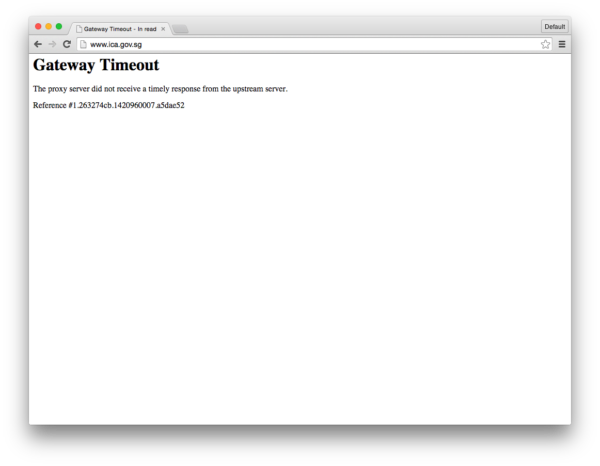
The Immigration and Checkpoint Authority’s (ICA) website has been down for some time. At least since November 2014, when a friend brought it to my attention. Most people don’t seem to notice, because the outage affects only IPv6 users. I’ve contacted ICA in December 2014, and for over a month, I’ve been assured the matter is receiving their attention. Nothing’s changed, even till today.
Clearly, ICA just couldn’t be bothered with me. They couldn’t be bothered with others too. I learned of another instance where ICA denied the problem when the same feedback was provided to them.
For a website to be down for even one hour should have been quite a big deal. People need to get to the ICA website for a variety of purposes. The only reason why this hasn’t blown up explosively is because the problem affects only IPv6 users.
What’s the deal with IPv6? It’s a new Internet Protocol that has been around for eons. It’s intended to replace IPv4, which still carries a significant proportion of all Internet traffic, because IPv4’s address space is pretty much exhausted. For several years now, we’ve been trying hard to move to IPv6. Our Infocomm Development Authority of Singapore (IDA) has been pushing IPv6 adoption, but it’s take-up is slow. Nevertheless, IDA had reported 95% of government agencies’ e-services to be IPv6 ready by March 2013. I don’t know what the actual progress has been like.
However, it’s clear that some agencies are simply going through the motion of adopting IPv6, and putting their websites or e-services on IPv6. For example, the in the case of ICA, they do have a published IPv6 DNS record. But the website doesn’t actually work on IPv6.

It’s a case of marking a checkbox, that they have IPv6 or some sort. Whether that service actually works or not, they cannot care.
This problem is affecting users who are IPv6 capable. IPv6 is getting quite prevalent in Singapore. Most, if not all, ISPs here support IPv6. The actual end-users may not have IPv6-capable broadband routers, or their IPv6-capable don’t have IPv6 service enabled. But certainly, the number of IPv6 capable users can only grow. The problem right now is that users who use IPv6, such as those who are dual-stack capable (i.e. they can use both IPv4 and IPv6), are unable to access ICA’s website.
The only solution for these users is to disable IPv6.
ICA has given me patronising responses like:
We would like to assure you that your concern is receiving our attention. As time is needed to look into the matter, we seek your patience and kind understanding on this, please.
Clearly, if they actually really cared a tiny weenie little bit, a website that is down should be fixed within an hour. It’s been over one month.
Thank you, IDA, for pushing new technologies and standards, and aiming to be at the forefront of a connected nation. Unfortunately, other parts of the government don’t seem to care.
PS: While researching this post, I found that several more government websites have the same exact problem. It seems this have-IPv6-but-not-quite-a-working-website plan isn’t a unique issue with ICA, but perhaps more widespread than I expected. Do you know which other government websites are these?
maybe because Singapore IPv6 adoption rate is only 1.5%. http://www.stateoftheinternet.com/trends-visualizations-ipv6-adoption-ipv4-exhaustion-global-heat-map-network-country-growth-data.html
otoh, our ISPs are also giving half-assed IPv6 implementations – see Starhub’s periodic downtimes, and Viewqwest’s no IPv6 since November.
So far after my numerous complaints last year, StarHub’s IPv6 has since appeared to be more reliable. 🙂
nobody really care about IPv6 because ISP still have lots of IPv4 blocks on hand, only new ISP with limited resource will try to push IPv6.
So far after my numerous complaints last year, StarHub’s IPv6 has since appeared to be more reliable. 🙂